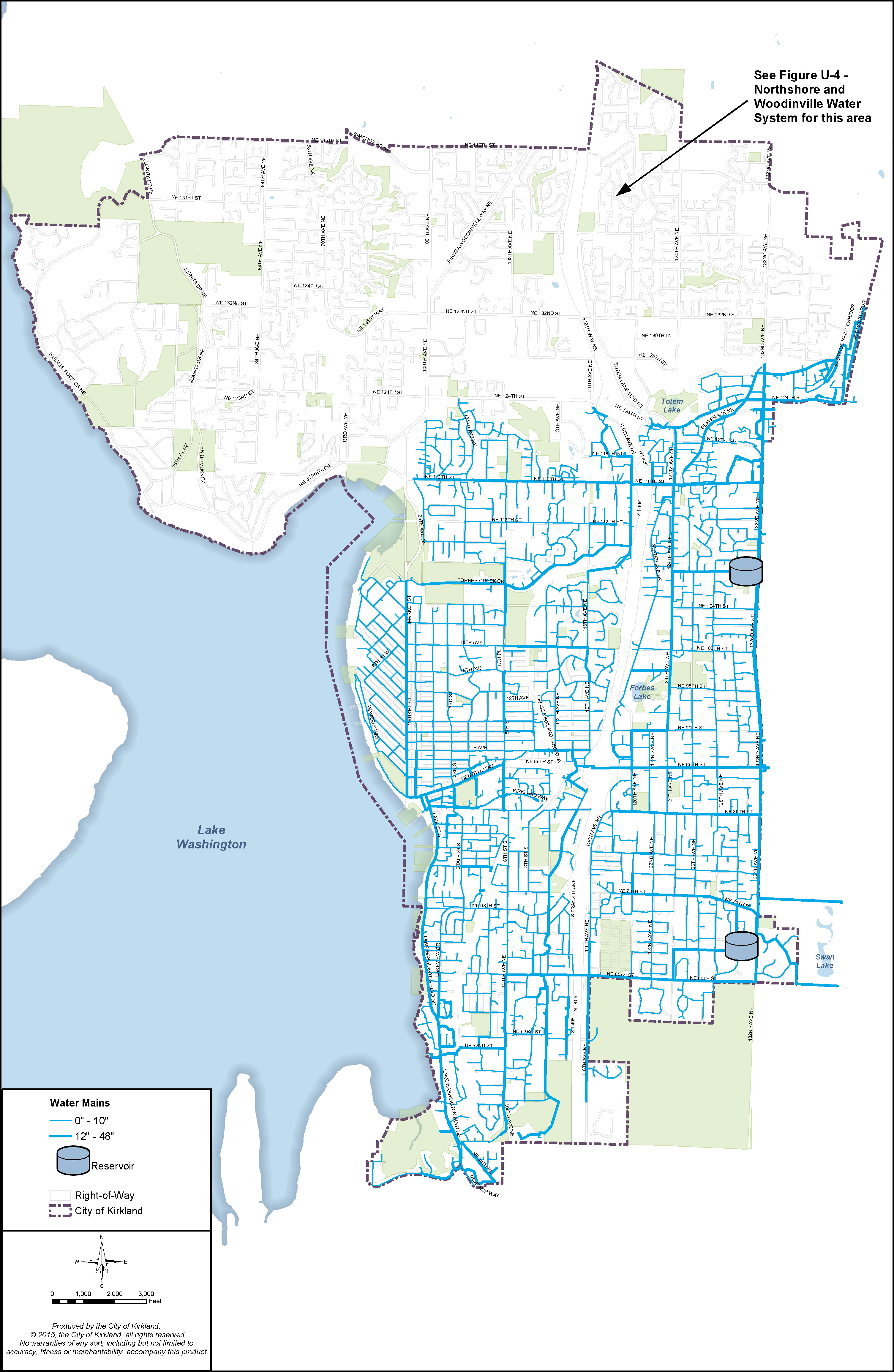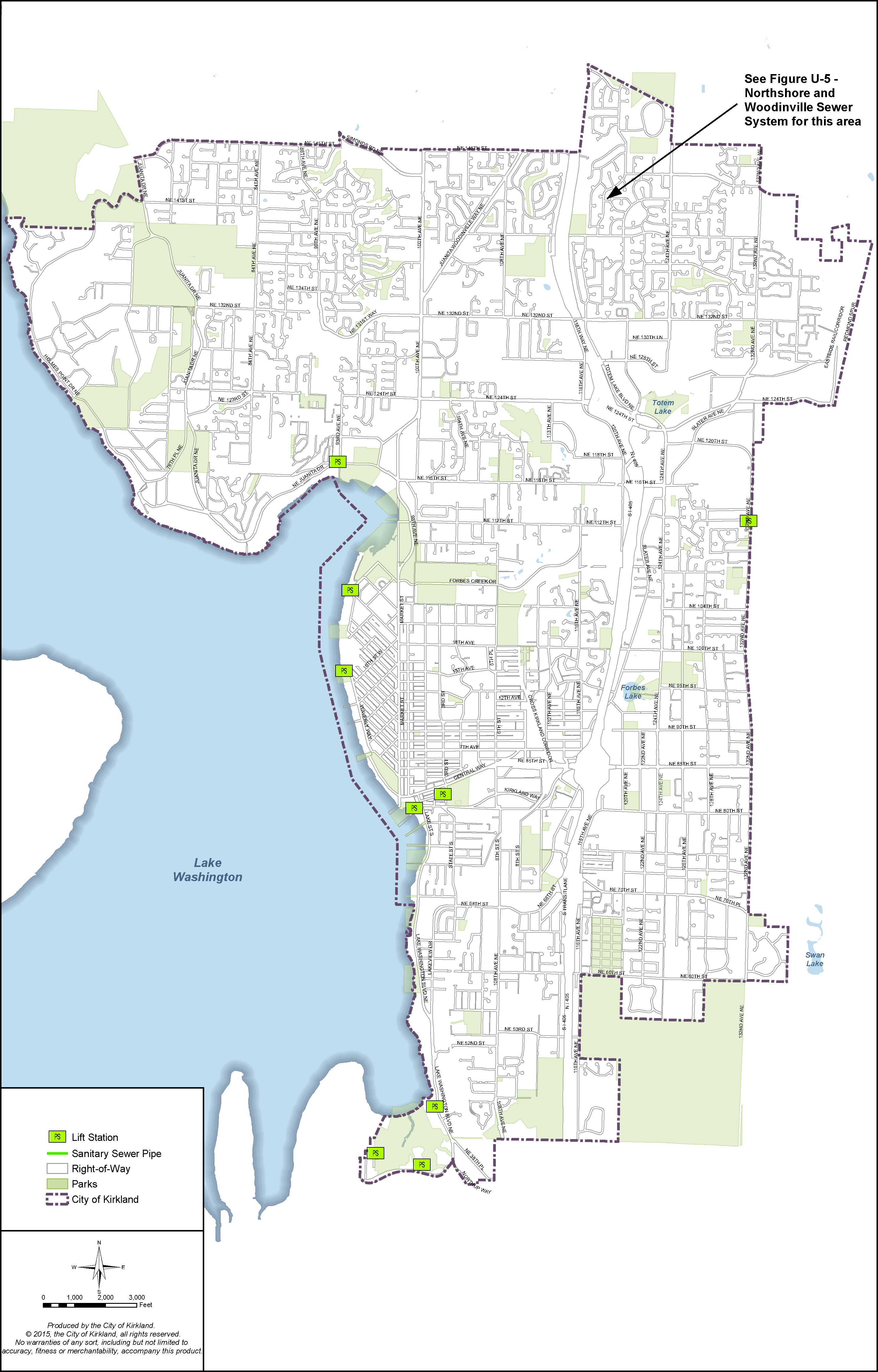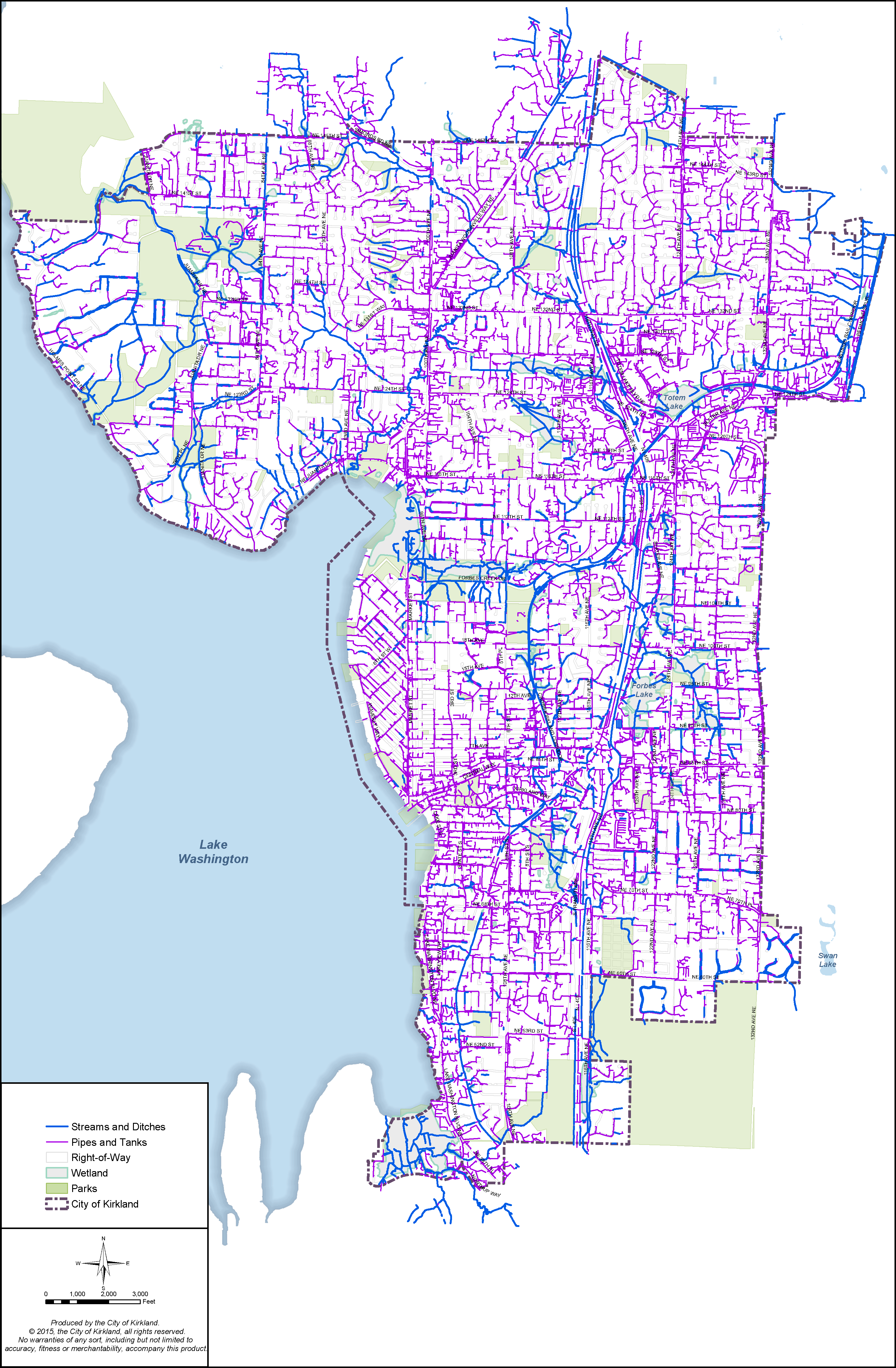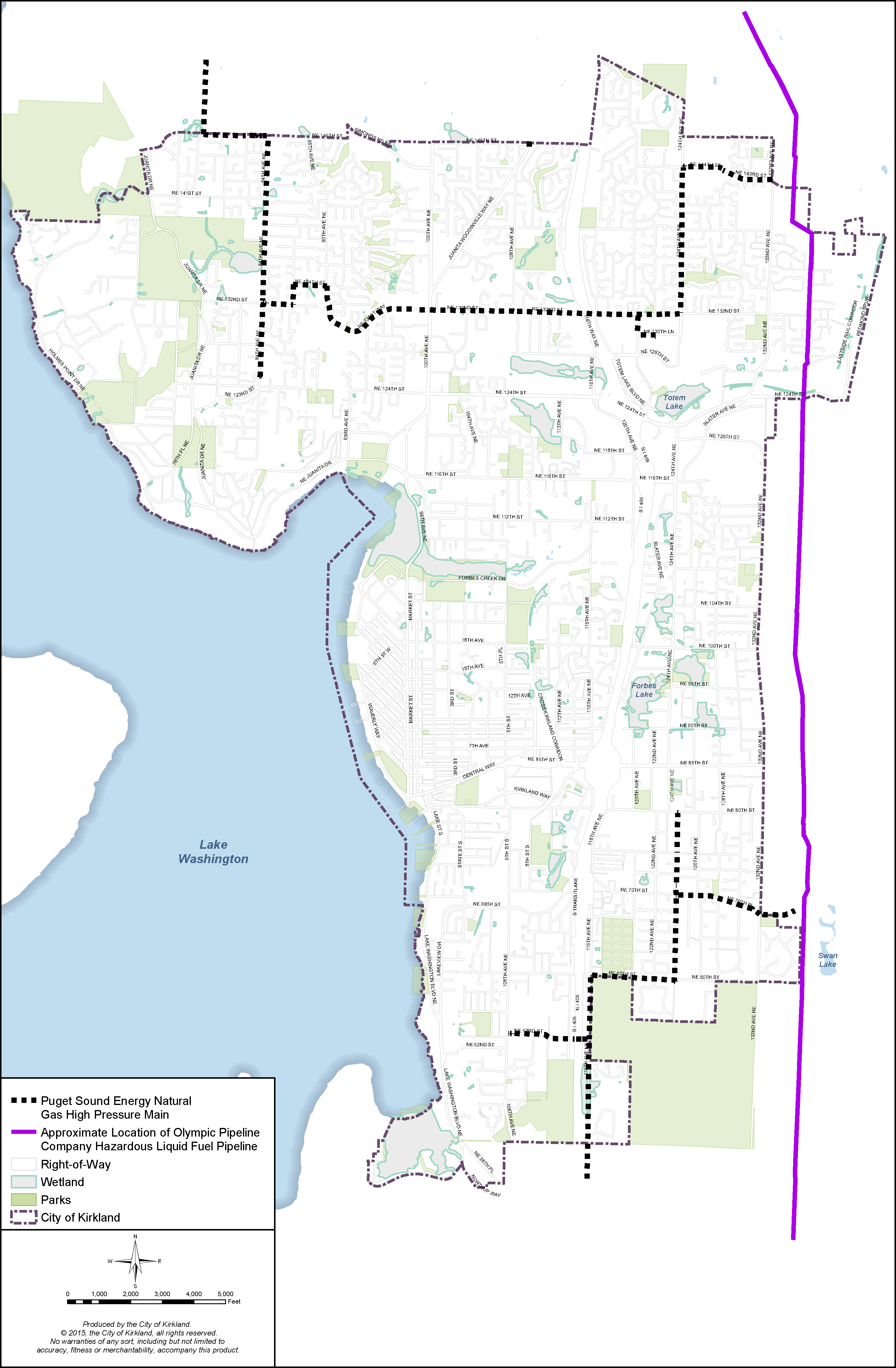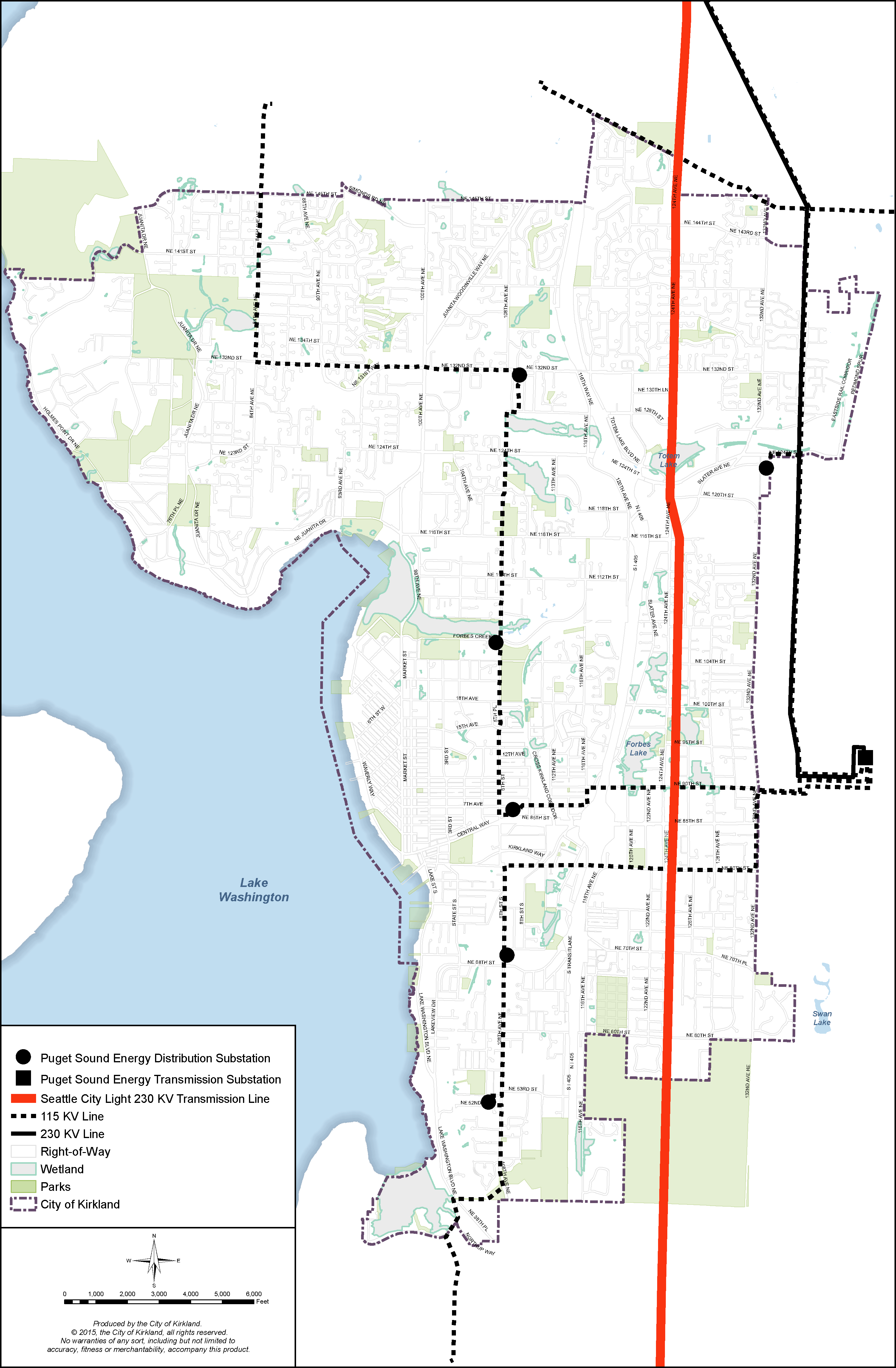A. Introduction
The Utilities Element addresses water, sewer, surface water, electric power, natural gas, telecommunications, and hazardous liquid pipelines.
Utility planning has contributed to a high quality of life for Kirkland residents and businesses by ensuring efficient utility delivery. Kirkland’s existing utility infrastructure is generally adequate to meet the growth needs of the City for many years. The City’s objective is to meet the needs of the present without compromising the ability of future generations to meet their own needs. The City will continue to:
♦ Upgrade existing systems to increase efficiency and to avoid maintenance problems associated with older facilities;
♦ Reduce demand through conservation; and
♦ Transition to renewable and alternative technologies to reduce greenhouse gas emissions.
Each utility function presents unique problems. For water, Kirkland faces regional supply issues that require regional solutions. For sewer, the City must consider how to service areas on septic systems as those areas become more urbanized, how to prevent non-degradable materials from entering the sewer system, and the possible future use of reclaimed water. For surface water, the City is challenged to manage a growing system to handle increased urbanization without flooding, while maintaining and enhancing water quality and aquatic habitat. For hazardous liquids, Kirkland land development regulations near the pipeline corridor will continue to be enforced to help reduce the risk of a pipeline accident. For telecommunications, the City will continue to develop its telecommunications network to meet the City’s needs and respond to changes in technology. Where possible, the City will utilize its telecommunications investments and partnerships to benefit citizens, businesses and public institutions. The City recognizes that excellent Internet connectivity is a key resource for business success. To that end, the City will work with telecommunications providers to help them succeed.
For both City and non-City-managed utilities, Kirkland faces the challenge of facilitating system improvements, efficiencies and new technologies while appropriately managing the impacts associated with above-ground utility installations.
Existing Conditions
The City of Kirkland currently provides the following utility services:
♦ Water – All areas of the City except those north of NE 124th Street that are outside the City’s service area. Figure U-1 shows the City’s water system.
♦ Sewer – All areas of the City except those north of NE 116th Street that are outside the City’s service area. Figure U-2 shows the City’s sewer system.
♦ Surface Water – All areas of the City. Figure U-3 shows the City’s surface water system.
The following non-City-managed utilities provide additional services:
♦ Northshore Utility District and Woodinville Water District – Both are special purpose districts that operate independently from the City. They provide water and sewer services to the northern portions of the City. Both have franchise agreements that include provisions for future City assumption of service at such time as it is desirable to do so. The Washington State Departments of Health and Ecology review and approve the Utility Districts’ Comprehensive Plans, and they are bound by the same service regulations as the City. Figures U-4 and U-5 show the water and sewer systems.
♦ Puget Sound Energy – Is a public service company – a corporation or other nongovernmental business entity which delivers certain services considered essential to the public interest. It transmits and distributes electric power and natural gas in a nine-county area, including Kirkland and much of King County. Figures U-6 and U-7 show Puget Sound Energy’s electrical and gas facilities.
♦ Telecommunications – Are provided by a variety of non-City managed companies. Kirkland has both wired and wireless telephone, cable TV, and high speed cable and fiber-optic Internet services. Those that use City rights-of-way to provide services have franchise agreements with the City.
City Managed Facilities
Water
The City of Kirkland Water Utility provides water service to all of its residents, except those generally north of NE 124th Street who are served by the Northshore Utility District or the Woodinville Water District (see Figure U-1). A very small portion of the southeastern City is served by the City of Bellevue.
The City’s water system is primarily a gravity system consisting of 171 miles of water lines and 12.62 million gallons of storage capacity that includes 1.5 million gallons of fire protection storage. An average of 5.3 million gallons of water per day is distributed to Kirkland’s water service area customers. Projected costs associated with the water system are primarily maintenance and replacement costs for aging pipe and fire flow needs. The system generally has sufficient capacity to serve growth anticipated through the land use plan and future water customers into the year 2035. The Kirkland Water System Plan outlines water projects to upgrade any deficiencies in the system for the next 20 years.
As a member of the Cascade Water Alliance, Kirkland purchases its water supply from Seattle Public Utilities. The water is then distributed to Kirkland customers through the City’s distribution system. The City currently receives all of its water supply from Seattle from the Tolt River Watershed, with occasional supply from the Cedar River Watershed when routine maintenance is required at the Tolt Treatment Facility. Cascade Water Alliance currently has an agreement with Seattle Public Utilities to provide 33.3 million gallons of water per day to its members through the year 2039 with the opportunity for an extension of the contract until 2063.
In addition to the supply from Seattle Public Utilities, Cascade Water Alliance also has an agreement with the City of Tacoma for additional supply into the year 2042, and has the capability of developing Lake Tapps in East Pierce County if the need arises beyond 2063. According to the Cascade Water Alliance, based on current trends of water use, responsible plumbing codes, and water efficient appliances, it is likely that Lake Tapps will not need be developed for decades.
Cascade Water Alliance Water Efficiency Program has a single regional water efficiency savings goal for all its members of a cumulative savings of 0.6 million gallons per day on an annual basis and 1.0 million gallons per day on a peak season basis through 2020. By utilizing existing water supplies more efficiently, millions of dollars will be saved for its members and ratepayers, leave more water in streams for fish, and reduce the region’s carbon footprint through decreased energy usage involved in the treatment, transmission and heating of drinking water.
Sewer
The City of Kirkland Sewer Utility provides sanitary sewer service to all of its residents south of NE 116th Street (see Figure U-2). The Northshore Utility District provides sewer service to most residents north of NE 116th Street.
The collection system consists of 40 wastewater collection basins, 122 miles of sewer pipe, six lift stations and force mains, and approximately 3,184 manholes. Approximately five to 10 percent of Kirkland residents use septic systems. Sewer extensions have typically been funded by developers or local owners in compliance with the Kirkland Municipal Code.
The system’s most serious deficiency is the age of some of the pipelines. Twenty percent of the conveyance system consists of concrete pipes that were installed prior to the 1950s. Many allow inflow/infiltration and root intrusions which reduce capacity of the system and increase operation and maintenance costs. In addition, downtown businesses that produce fats, oils, and grease (FOG) release damaging amounts into conveyance pipes, contributing to odors downtown and increasing the risk of overflows. As a founding member of the Northwest FOG alliance, the City continues to lead the region in its efforts to educate businesses about proper kitchen practices and regular cleaning of FOG controls to prevent these impacts. The primary costs anticipated to maintain existing levels of service are related to replacement and rehabilitation of older pipelines, improvement of pumping capacity, and system expansions in the Lake Plaza Basin, Central Way Basin, and Juanita Basin.
The Kirkland Sewer Plan establishes the policy basis for recommended capital improvements to correct deficiencies and meet future service needs. The Plan provides the City with a guide to evaluate the impact of possible reclaimed water use and future development and land use on the local and regional sewer system.
The King County Wastewater Treatment Division (WTD) provides the City’s service area with sanitary sewer treatment services under the terms of an intergovernmental agreement. City sewage and a majority of Northshore Utility District’s sewage are treated at King County’s Renton treatment plant. The Brightwater Treatment plant in Woodinville supplies reclaimed water to the region and is currently located at Willows and NE 12th Street. Very small portions of Northshore’s sewage flows to the Brightwater Treatment Plant in Woodinville and the West Point Treatment Plant in Seattle.
King County WTD’s review of regional conveyance and treatment plants’ capacity indicates that the existing capacity is adequate to treat the region’s wastewater until the 2030s. Planned upgrades to the treatment facilities will occur in order to maintain adequate capacity to serve anticipated growth beyond the 2030s.
Surface Water
The City maintains conveyance, flow control and water quality treatment systems in public rights-of-way, and flow control and water quality treatment facilities that serve single-family developments. These facilities are managed to reduce flooding and to protect water quality. As of 2014, the City owns and manages 257 miles of conveyance pipe and 539 retention and detention facilities (i.e., tanks, vaults and ponds).
Privately owned stormwater facilities consist of conveyance, flow control and water quality treatment facilities that serve multifamily and commercial developments, and certain private roads and single-family developments. City staff inspect 631 private flow control and water quality treatment systems to insure that they are cleaned and functioning as designed. In addition, staff provide technical assistance for drainage and water quality problems that impact these systems. Figure U-3 shows the City surface management water system.
The Kirkland Surface Water Master Plan is a functional plan that Kirkland uses to identify capital projects to address deficiencies in the system. This provides the policy basis for capital projects.
Kirkland is subject to the Phase II Western Washington Municipal Stormwater Permit (the “Permit”). The Permit is issued by the State of Washington under authority from the Environmental Protection Agency, and is part of the National Pollutant Discharge Elimination System (NPDES), a program which seeks to reduce pollution in the nation’s waterways by controlling sources of pollution. The current Permit became effective on August 1, 2013, and will expire on July 31, 2018. The Permit allows Kirkland to discharge stormwater into waters of the State (Lake Washington) if the City takes specific steps in each of the following areas to minimize discharge of pollutants to stormwater: public education and outreach, public involvement, illicit discharge detection and elimination, controlling runoff from new development, redevelopment, and construction sites, municipal operations and maintenance, and monitoring and effectiveness studies.
A watershed approach has been used for managing the surface water utility by dividing the City into 15 drainage basins. The largest and most important streams are Juanita and Forbes Creek. The size of their drainage basins makes them especially important for receipt of stormwaters and discharge into Lake Washington. Yarrow Creek, Denny Creek, Juanita Creek, Forbes Creek, and Champagne Creek also have large basin areas within the City and are significant because they provide salmonid fish habitat and productive associated wetlands. Smaller critical drainages include Carillon Creek, Cochran Springs Creek, Everest Creek, Holmes Point, and Kingsgate Slope. More information on the watershed and drainage basins, and a map illustrating their location, can be found in the Natural Environment Element.
City Telecommunications
The City is expanding its fiber-optic network to service governmental facilities and traffic control systems by partnering with other cities and schools to lay the foundation for a regional fiber-optic telecommunication system. The publicly owned Community Connectivity Consortium has 22 members including Kirkland, Lake Washington School District, the University of Washington and the City of Bellevue.
Figure U-1: Water System
Figure U-2: Sanitary Sewer System
Figure U-3: Surface Water Management System
Non-City-Managed Utilities
Northshore Utility District: Water and Sewer
The Northshore Utility District provides water and sewer services to northern portions of the City. Figure U-4 illustrates the existing Northshore water system. Figure U-5 illustrates the existing Northshore sewer system.
Northshore’s sewer system is primarily a gravity system. Wastewater is treated at King County’s West Point and Renton treatment plants. Sewer Level of Service is 71 gallons per capita flow rate. Potable water from the Tolt River Watershed is purchased from Seattle Public Utilities (SPU). The water system has five reservoir sites with a 29-million-gallon capacity. Water Level of Service is 174 gallons per day (GPD) per equivalent residential units (ERU).
The District’s sewer and water plans include identification of capital improvements for replacement and repair of the older, damaged sections of the system. Repair and maintenance of the system occur when needed and extensions necessitated by future development will be provided by the developer.
The District, as one of a group of 18 utilities who also purchase water from SPU, are part of the Saving Water Partnership (SWP) administered by SPU. All have adopted the Saving Water Partnership Regional Conservation Program Water Use Efficiency Goal. The conservation goal is to reduce per capita water use from current levels so that the total average annual retail water use of members of the SWP is less than 105 million gallons per day (MGD) from 2013 through 2018 despite forecasted population growth. Due to the high cost of connecting to the Brightwater Wastewater Treatment Facility reclaimed water distribution system, the District does not currently have sufficient need or cost-justification to develop and manage a reclaimed water distribution system. They will continue to evaluate the feasibility of doing so in the future.
Northshore can provide service to accommodate Kirkland’s future growth.
Woodinville Water District: Water and Sewer
The Woodinville Water District provides water services to the northeast portion of the City and sewer service to only a few single-family homes. Figure U-4 illustrates the existing Woodinville water system. Figure U-5 illustrates the existing Woodinville sewer system.
Woodinville’s sewer system is primarily a gravity system. Due to the topographical difficulty of providing gravity sewer service to the Kingsgate area, Northshore Utility District provides sewer service there, even though it is within Woodinville’s service area. Woodinville Water wastewaters are treated at King County’s West Point and Renton treatment plants. Sewer level of service is 75 gallons per day per capita. Woodinville’s Sewer General Plan indicates that Woodinville Water district can provide sewer service to accommodate Kirkland’s future growth.
The water system has eight reservoir sites with a 14.9-million-gallon capacity. Water level of service is 193 gallons per day (GPD)/equivalent residential units (ERU). Woodinville’s Comprehensive Water System Plan indicates that by the year 2027, the District’s water needs in the west service area, which includes Kirkland, will be deficient of source availability for projected demands and fire suppression storage. The District has a capital improvement plan for the system. Depending on future demand, a new water reservoir will be built to provide new capacity where the existing Kingsgate reservoir is located. In the meantime, a new booster pump station at this site has delayed the need for the new reservoir. Repair and maintenance of the system occur when needed and extensions necessitated by future development will be provided by the developer.
The district’s conservation goal is to reduce per capita water use from current levels so that the total average annual retail water use of the members of Seattle Public Utilities Saving Water Partnership is less than 105 million gallons per day (MGD) from 2013 – 2018 despite forecasted population growth.
Puget Sound Energy: Electricity and Natural Gas
Puget Sound Energy (PSE) provides the Kirkland area with natural gas and electricity and is regulated by the Washington Utilities and Transportation Commission (WUTC). Figure U-6 illustrates the existing natural gas system. Figure U-7 illustrates the existing electrical system.
Electricity
PSE generates, transmits, and distributes power as part of the interconnected Northwest power grid. As of 2014, PSE generates approximately 46 percent of its electricity from their own power plants and acquires the rest from generation sources on the Columbia River and across the western United States and Canada. The electricity that PSE delivers to customers is generated from hydroelectric dams, coal, natural gas, wind, and to a much smaller degree from nuclear, and other (solar, biomass landfill gas, petroleum, and waste). Although there has historically been a net surplus in electricity supply in the Northwest, in recent years there has been a balance between supply and demand. Future forecasts indicate scenarios where deficits may emerge, requiring additional power purchases, new generation, and further conservation.
Kirkland is a part of PSE’s Eastside and Northshore Electrical Subareas. Power is delivered on 230,000 volt (230 kV) transmission lines to substations in Redmond and Renton, where the voltage is transformed to 115 kV. Several distribution stations in Kirkland further transform the voltage to 12.5 kV which is then distributed to customers. A new 115 kV transmission line connecting PSE’s Sammamish Substation in Redmond to Kirkland’s Juanita Substation is planned for construction in 2017 along a route that enters Kirkland near NE 124th Street and generally follows the Cross Kirkland Corridor until heading north along 120th Avenue NE, and then west along NE 124th Street.
A double-circuit 230 kV Seattle City Light transmission line runs through Kirkland north to south near 124th Avenue NE, but does not directly serve the Eastside subarea.
PSE’s long-range electrical energy plans through the year 2035 include a new 230 kV transmission line to connect Redmond to Renton. Known as the Energize Eastside Project, siting of the new transmission line goes through a public involvement process that is expected to be complete at the end of 2015, followed by environmental review and permitting in 2015 – 2017. Construction is planned for 2017 – 2018.
Washington State’s Energy Independence Act requires utilities to acquire specified amounts of renewable resources or equivalent renewable energy credits (RECs). Sufficient “qualifying renewable energy” must equal at least three percent of retail sales in 2012, nine percent in 2016 and 15 percent in 2020. PSE has acquired enough eligible renewable resources and REC’s to meet the requirements of the law through 2022 from wind resources.
Natural Gas
PSE provides natural gas to six Washington counties, including King County via PSE’s distribution system. The natural gas originates from various regions of the U.S. and Canada. Natural gas is transported throughout Washington via a network of interstate transmission pipelines owned and operated by Northwest Pipeline Corporation. PSE takes delivery of natural gas from Northwest at a gate station located east of Lake Sammamish outside Kirkland City limits. PSE gas distribution lines up to eight inches in diameter in Kirkland, together with future extensions and upgrades, will service Kirkland’s growth.
While PSE plans for gas system demand growth, installation of gas main extensions and new service lines respond to customer demand. Washington Utilities and Transportation Commission rules require gas companies to demonstrate that existing ratepayers will not subsidize new customers.
Telecommunication Service Providers
Telephone services are regulated by the Washington Utilities and Transportation Commission. Personal wireless service providers serving Kirkland are those licensed by the Federal Communications Commission (FCC) in the radio frequency spectrum for wireless communications service and registered to do business in Kirkland. Cable services are provided under municipal franchise.
Telephone
Wired telephone service and certain related special services are available in the City. System facilities within Kirkland include switching stations, trunk lines, and distribution lines. Distribution lines are either pole-mounted or underground. Service and facility expansions are driven by customer demand.
Personal Wireless
Several companies provide wireless (cellular) telephone service. Cellular telecommunication permits wireless transmission of messages on a network of strategically placed receivers (i.e., mobile telephone communications). Receivers may be placed on tall poles, lattice-type towers, or buildings. The cellular telephone industry does not plan facilities far into the future, but uses market demand to determine expansion into new service areas.
Cable
Cable TV and Internet services are also available in Kirkland. Most homes are served by at least two providers. The local provider has the technical capacity to serve any new development in the City. Residential high speed DSL services, cable-based Internet, and fiber are available in most locations in the community.
Fiber Optic
Many telecommunication vendors own optic fiber in Kirkland rights-of-way for commercial use. The City of Kirkland has access to some of these strands through franchise agreements.
Broadband
Broadband Internet Services are available nearly everywhere in Kirkland via commercial telecommunications providers. The City of Kirkland encourages competition among telecommunications providers, broadband accessibility for all locations and incomes, and build-out of gigabit symmetrical services for homes and businesses in Kirkland. Gigabit speed is 1,000 megabits per second and is expected to meet consumer and small business demand for entertainment, communication, education, and other computing needs for the next decade. Symmetrical services means an equivalent amount of both download and upload capability.
Olympic Pipeline Company: Hazardous Liquid Pipelines
The Olympic Pipeline Company, operated by BP Pipelines, North America, operates a 400-mile-long petroleum pipeline system from Ferndale, Washington, to Portland, Oregon. Two parallel lines, 16-inch and 20-inch in diameter, generally along the Puget Sound Energy easement north-south corridor, pass through the Kingsgate and Totem Lake neighborhoods in the northeast portion of Kirkland and close to a portion of the eastern boundary of the Bridle Trails neighborhood (see Figure U-6). The pipelines carry gasoline, diesel and aviation fuel. Delivery lines carry products from this mainline to bulk terminals at Sea-Tac International Airport; Seattle, Tacoma and Vancouver, Washington; and Linnton and Portland, Oregon.
The pipelines are hazardous liquid pipelines, as defined by state law (RCW 81.88.040). Pipeline facilities, if ruptured or damaged, can pose a significant risk to public safety and the environment due to the high operating pressure and the highly flammable, explosive and toxic properties of the fuel.
The Federal Office of Pipeline Safety (OPS) is responsible for regulation of the interstate pipeline facilities and addresses safety in design, construction, testing, operation, maintenance and emergency response of pipeline facilities. The Washington State Utilities and Transportation Commission (UTC) has authority to act as an agent for OPS.
Kirkland’s Fire Department has reciprocal emergency response agreements with Redmond and other surrounding jurisdictions in the event of a pipeline failure. The Redmond Fire Department Olympic Pipeline Response Plan includes technical information about the pipeline, potential hazards, a guide to hazardous materials scene management, emergency response and evacuation plans, and contacts and other resources. It contains the fundamentals of the City of Kirkland Fire Department response, and in addition maintains City specific data to be used in such an emergency.
The City has established policies to supplement state regulations and the City’s risk management/response plan. Utility Element policies focus primarily on land use measures that help minimize and prevent unnecessary risk to the public due to hazardous liquid pipelines, recognizing it is impossible to eliminate risk entirely.
The City also enforces the State’s Call Before You Dig Law to safeguard the public and construction personnel who work around utilities and the underground infrastructure of pipes, mains, and lines, including fiber optic lines, with an emphasis on protecting fuel transport lines. It requires notification when excavating near underground utilities and ensures that they will be marked, in order to prevent damage, service interruptions and bodily injury.
Figure U-4: Northshore and Woodinville Water Systems
Figure U-5: Northshore and Woodinville Sewer Systems
Figure U-6: Natural Gas and Hazardous Liquid Transmission System
Figure U-7: Electrical Transmission System
Relationship to Other Elements
The Utilities Element supports other elements of the Comprehensive Plan by establishing policies for provision of efficient and sustainable urban services to serve anticipated growth and development. This Element supports an infrastructure for servicing existing development and areas targeted for growth by the Land Use Element. The general policies in this Element support the Shoreline Area Chapter by encouraging joint use of utility corridors and mitigating environmental impacts caused by the utility. Energy policies support the sustainability objectives found in the Environment Chapter. The telecommunications policies will help implement the policies of the Land Use, Economic Development, Transportation, and Public Services Elements by facilitating the movement of information as an alternative to the historic commuter/work relationship. Finally, utility policies provide direction to the funding, concurrency, and level of service goals and policies of the Capital Facilities Element. The Capital Facilities Element contains further explanation regarding the analysis of need for capital projects to meet the level of service standards for City managed utilities.
Policies for public services such as emergency services, schools, and libraries are contained in the Public Services Element.
Relationship to Other Plans
In preparing this Element, the City has reviewed and considered the following documents that are adopted by reference:
♦ City of Kirkland Water System Plan;
♦ City of Kirkland Sewer Plan;
♦ City of Kirkland Surface Water Master Plan;
♦ Washington State Department of Ecology Stormwater Management Manual for Western Washington;
♦ Northshore Utility District Water Plan;
♦ Northshore Utility District Wastewater System Plan;
♦ Northshore Utility District Sewer and Water Plan Maps;
♦ Woodinville Water District Comprehensive Water Plan;
♦ Woodinville Water District General Sewer Plan;
♦ Puget Sound Energy GMA Electrical Facilities Plan;
♦ Redmond Fire Department Olympic Pipeline Response Plan.



.97118.JPG)
